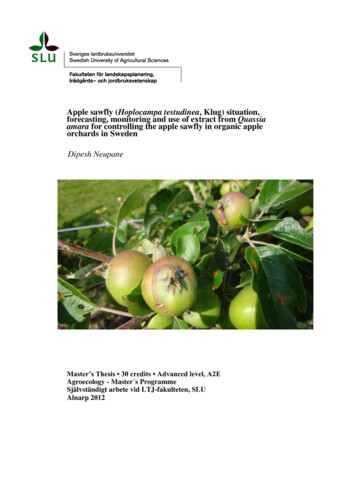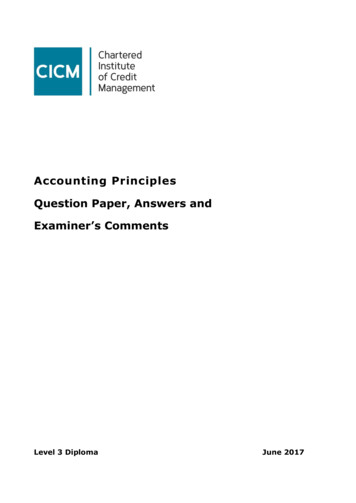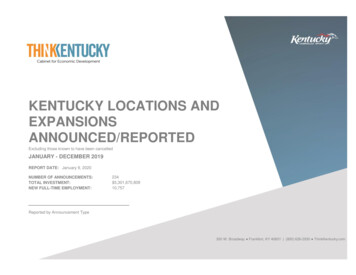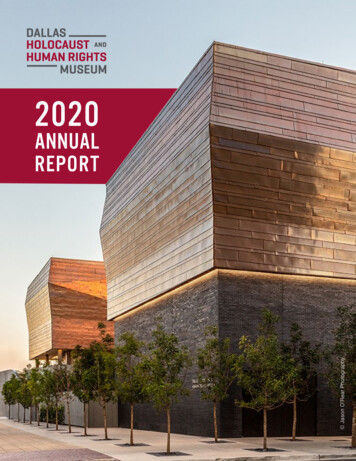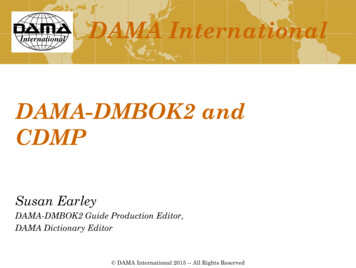
Transcription
InternationalDAMA InternationalDAMA-DMBOK2 andCDMPSusan EarleyDAMA-DMBOK2 Guide Production Editor,DAMA Dictionary Editor DAMA International 2015 -- All Rights Reserved
AgendaThe DAMA-DMBOK2Data Management OverviewEnvironmental ElementsKnowledge AreasAdditional TopicsICCP and Certification Testing
DAMA-DMBOK2DAMA-DMBOK2 PurposeThe DAMA-DMBOK2 Guide is intended tobe a definitive introduction to datamanagement as it currently exists.
DAMA-DMBOK2 Goals1. To build consensus for a generally applicable view of datamanagement Knowledge Areas.2. To provide standard definitions for commonly used datamanagement Knowledge Areas, deliverables, roles, and otherterminology.3. To identify guiding principles for data management.4. To overview commonly accepted good practices, widely adoptedmethods and techniques, and significant alternative approaches,without reference to specific technology vendors or their products.5. To briefly identify common organizational and cultural issues.6. To clarify the scope and boundaries of data management.7. To guide readers to additional resources for further understanding.
DAMA-DMBOK2 Audience Certified and aspiring data management professionals.Other IT professionals working with data management professionals.Data stewards of all types.Executives with an interest in managing data as an enterprise asset.Knowledge workers developing an appreciation of data as an enterpriseasset.Consultants assessing and helping improve client data managementKnowledge Areas.Educators responsible for developing and delivering a data managementcurriculum.Researchers in the field of data management.
DAMA-DMBOK2 Uses Informing a diverse audience about the nature and importance of datamanagement.Helping standardize terms and their meanings within the data managementcommunity.Helping data stewards and data management professionals understand theirroles and responsibilities.Providing the basis for assessments of data management effectiveness andmaturity.Guiding efforts to implement and improve their data management KnowledgeArea.Pointing readers to additional sources of knowledge about data management.Guiding the development and delivery of data management curriculumcontent for higher education.Suggesting areas of further research in the field of data management.Helping data management professionals prepare for CDMP and CBIP exams.
DAMA-DMBOK2Other BOK Guides A Guide to the Project Management Body of Knowledge (PMBOK Guide), published by the Project Management Institute (PMI ). PMI is aprofessional organization for project managers.A Guide to the Software Engineering Body of Knowledge (SWEBOK),published by the Institute of Electrical and Electronic Engineers (IEEE).A Guide to the Enterprise Information Technology Body of Knowledge(EITBOK), soon to be available as a wiki, published by IEEE.The Business Analysis Body of Knowledge (BABOK), published by theInternational Institute of Business Analysis (IIBA).The Common Body of Knowledge (CBK) published by the InternationalInformation Systems Security Certification Consortium ((ISC).The Canadian Information Technology Body of Knowledge (CITBOK) is aproject undertaken by the Canadian Information Processing Society(CIPS) to outline the knowledge required of a Canadian InformationTechnology Professional.
DAMA-DMBOK2 wheels11 DataManagementKnowledgeAreas7 EnvironmentalElements
Environmental ElementsGoals and Principles:The directional business goals of each knowledge area and the fundamentalprinciples that guide performance of each Knowledge Area.Goals also include Metrics to measure success. Data Management Program Metrics Data Value Metrics Data Quality Metrics
Environmental ElementsActivities:Each knowledge area is composed of lower level activities. Some activitiesare grouped into sub-activities. Activities are further decomposed into tasksand steps.1.Data Governance2.Data Architecture3.Data Modeling and Design4.Data Storage and Operations5.Data Security6.Reference and Master Data7.Data Warehousing and Business Intelligence8.Data Integration and Interoperability9.Documents and Content10.Metadata11.Data Quality
Environmental ElementsDeliverables:The information and physical databases and documents created as interim andfinal outputs of each knowledge area. Some deliverables are essential, someare generally recommended, and others are optional depending oncircumstances. Data Strategy Data Architecture Data Services Databases Data, Information, Knowledge, and Wisdom
Environmental ElementsRoles and Responsibilities:The business and IT roles involved in performing and supervising theknowledge area , and the specific responsibilities of each role in thatknowledge area. Some roles will participate in multiple Knowledge Areas.SuppliersResponsibleConsumersProvide input intothe ActivitiesPerforms the ActivitiesConsumes outputfrom the ActivitiesStakeholderHas an interest in, orgains a benefit from,the Activities
Environmental ElementsPractices and Techniques:Common and popular methods and procedures used to perform the processes andproduce the deliverables.Practices and Techniques include common conventions, best practice recommendations, and alternative approaches without elaboration.
Environmental ElementsToolsets:Categories of supporting technology (primarily software tools), standards andprotocols, product selection criteria and common learning curves. Inaccordance with DAMA International policies, specific vendors or productsare not mentioned. Data Modeling Tools Database Management Systems Data Integration and Quality Tools Business Intelligence Tools Document Management Tools Metadata Repository Tools
Environmental ElementsOrganization and Culture: Management Metrics – measuresof size, effort, time, cost, quality,effectiveness, productivity,success, and business value. Critical Success Factors. Reporting Structures. Contracting Strategies. Budgeting and Related ResourceAllocation Issues. Teamwork and Group Dynamics.Authority and Empowerment.Shared Values and Beliefs.Expectations and Attitudes.Personal Style and PreferenceDifferences. Cultural Rites, Rituals and Symbols. Organizational Heritage. Change ManagementRecommendations.
Knowledge AreasKnowledge Areas (KAs)1.2.3.4.5.6.7.8.9.10.11.Data GovernanceData ArchitectureData Modeling and DesignData Storage and OperationsData SecurityReference and Master DataData Warehousing and Business IntelligenceData Integration and InteroperabilityDocuments and ContentMetadataData Quality
Knowledge Area ContextContext DiagramDefinition:Activities:Deliverables:Existing orRequirements for· Rules· Standards· Regulations· Models· Data· Metadata· (outputs from otherKAs)1. Data Governance2. Data Architecture3. Data Modeling and Design4. Data Storage and Operations5. Data Security6. Data Integration and Interoperability7. Records and Content8. Reference and Master Data9. Data Warehousing and Business Intelligence10. Metadata11. Data QualityNew or Updated· Procedures· Rules· Standards· Models· Data· Metadata· (inputs to other KAs)InputsSuppliersDeliver InputsSupplier Roles:·Defined Roles that supplyor provide the Inputs.Responsible Roles:·Defined Roles that Performthe ActivitiesOutputsTechnicalDriversGoals are measured by MetricsInputs:ConsumersReceive DeliverablesToolsets:· Classes of Software used to perform or manageActivitiesConsumer Roles:Techniques:· Defined Procedures or Techniques used to performActivities with good successStakeholder Roles:Metrics:·Defined measurements that can be compared toexpectations to determine success of the Activities.··Defined Roles that receiveand use the Deliverables.Defined Roles invested inachieving Goals.Stakeholders benefit from achieving GoalsBusinessDriversGoals:1. Measurable desired outcomes from Activities
Knowledge Area ContextDefinition – What is the Knowledge Area?Goals – What does the Knowledge Area accomplish? Why does the Knowledge Areaexist?Activities – What are the Knowledge Area’s tasks that accomplish the goals?Inputs – What do the Knowledge Area’s tasks use?Suppliers – Who provides the inputs to the Knowledge Area’s tasks?Responsible – Who is performs the Knowledge Area?Tools – What tools do the Knowledge Area’s tasks use?Deliverables – What does the Knowledge Area deliver?Consumers – Who uses the primary deliverables?Stakeholders – Who has an interest in the Knowledge Area’s success?Metrics – What is used to measure the Knowledge Area’s success?Note: no where, how, when
Activity GroupsActivity Groups:Each activity belongs to one of four Activity Groups: Planning Activities (P)Activities that set the strategic and tactical course for other datamanagement activities. Planning activities may be performed on arecurring basis. Development Activities (D)Activities undertaken within implementation projects and recognized aspart of the systems development lifecycle (SDLC), and creating datadeliverables through analysis, design, building, testing, preparation, anddeployment. Control Activities (C)Supervisory activities performed on an on-going basis. Operational Activities (O)Service and support activities performed on an on-going basis.
Data ManagementData Management OverviewDefinition: The planning, execution and oversight of policies,practices and projects that acquire, control, protect, deliver, andenhance the value of data and information assets.Mission: To meet the data availability, quality, and security needsof all stakeholders.
Data ManagementGoals:1. To understand the information needs of the enterprise and all itsstakeholders.2. To capture, store, protect and ensure the integrity of data assets.3. To continually improve the quality of data and information, including: Data accuracy.Data integrity.Data integration.The timeliness of data capture and presentation.The relevance and usefulness of data.The clarity and shared acceptance of data definitions.4. To ensure privacy and confidentiality, and to prevent unauthorized orinappropriate use of data and information.5. To maximize the effective use and value of data and information assets,by Controlling the cost of data management.Promoting a wider and deeper understanding of the value of data assets.Managing information consistently across the enterprise.Aligning data management efforts and technology with business needs.
Data ManagementGuiding Principles1. Data and information are valuable enterprise assets.2. Manage data and information carefully, like any other asset, by ensuringadequate quality, security, integrity, protection, availability,understanding, and effective use.3. Share responsibility for data management between business data stewards(trustees of data assets) and data management professionals (expertcustodians of data assets).4. Data management is a business Knowledge Area and a set of relateddisciplines.5. Data management is also an emerging and maturing profession with the ITfield.
Data ManagementData ManagementDefinition: The planning, execution and oversight of policies, practices and projects that acquire, control, protect,deliver, and enhance the value of data and information assets.Goals:BusinessDrivers1. To understand the information needs of the enterprise and all its stakeholders.2. To capture, store, protect, and ensure the integrity of data assets.3. To continually improve the quality of data and information.4. To ensure privacy and confidentiality, and to prevent unauthorized or inappropriate use of data andinformation.5. To maximize effective use and value of data and information assets.Inputs:Activities:Deliverables:· Business and ITStrategy· Business Activity· Regulations· Processes· Models· Metadata· Outputs from otherKAs1. Data Governance2. Data Architecture3. Data Modeling and Design4. Data Storage and Operations5. Data Security6. Data Integration and Interoperability7. Records and Content8. Reference and Master Data9. Data Warehousing and Business Intelligence10. Metadata11. Data QualityNew or Updated· Data Strategy· Data Architecture· Data Services· Databases· Metadata· Inputs to other KAsSupplier Roles:····Officers and ExecutivesData CreatorsRegulatory bodiesExternal SourcesResponsible Roles:··IT Data Management teamsBusiness Data Steward lsets:· Data Modeling Tools· Database Management Systems· Data Integration and Quality Tools· Business Intelligence Tools· Document Management Tools· Metadata Repository ToolsConsumer Roles:Techniques:· Best PracticesStakeholder Roles:Metrics:·Data Value metrics·Data Usage metrics(P) Planning, (C) Control, (D) Development, (O) Operations······Clerical WorkersKnowledge workersManagementOfficers and ExecutivesCustomersEmployees in general
BREAK
Knowledge Areas1. Data GovernancePlanning, supervision and control over data management and use.1.1 Data Governance and StewardshipGoals1. Define, approve, communicate, and implement principles, policies,procedures, metrics, tools, and responsibilities for datamanagement.2. Track and enforce compliance to regulatory and internal datapolicies.3. Monitor and guide data usage and management activities.Activities1.2.3.4.5.(P) Define Data Governance for the organization(P) Define the Operating Framework(P) Create and implement data principles and policies(P) Define roles(O) Implement and sustain
Knowledge Areas1. Data GovernancePlanning, supervision and control over data management and use.1.2 Business Cultural DevelopmentGoals1. To define a data-centric organization2. To understand how business culture development supports datagovernance3. To define change management activities that can support datamanagement and business culture alignment4. To highlight the need for communication and training in datamanagement activitiesActivities1. (P) Create a data-centric organization2. (D) Develop organizational touchpoints3. (C) Develop data-centric culture controls
Knowledge Areas1. Data GovernancePlanning, supervision and control over data management and use.1.3 Data in the CloudGoals1. Define, contract, implement, and monitor cloud based datamanagement areas of programs.2. Define implement/contract, monitor and report SLAs on internal andexternal data stores.Activities1.2.3.4.5.6.7.(P) Assess organizational readiness(P) Define cloud and outsourcing requirements for the organization(P) Define and (D) execute contracting requirements(P) Select and (D) execute cloud infrastructure vendor environment(D) Develop security rules and ETL/capture data change (CDC) code(O) Operationalize cloud data activities(C) Report on service monitoring
Knowledge Areas1. Data GovernancePlanning, supervision and control over data management and use.1.4 Data Handling EthicsGoals1.2.3.4.5.(P) Review Data-Handling Practices(P) Develop the Ethical Data Handling Strategy(D) Communicate and Educate Staff(D) Address Practices Gaps(C) Monitor and Maintain AlignmentActivities1.2.3.4.5.(P) Review Data-Handling Practices(P) Develop the Ethical Data Handling Strategy(D) Communicate and Educate Staff(D) Address Practices Gaps(C) Monitor and Maintain Alignment
Knowledge Areas2. Data ArchitectureDefining the blueprint for managing data assets.Goals1. Plan with vision and foresight to provide high quality data.2. Identify and define common data requirements.3. Design conceptual structures and plans to meet the current andlong-term data requirements of the enterprise.Activities1. (P) Establish Enterprise Data Architecture1. Select Specific Reference Frameworks2. Adopt Specific Frameworks3. Work Within Enterprise Architecture4. Develop a Roadmap5. Enterprise vs Project Architecture Models2. (C) Design and Implement Data Architecture
Knowledge Areas3. Data Modeling and DesignData modeling is the process of discovering, analyzing, and scoping datarequirements, and then representing and communicating these datarequirements in a precise form called the "data model".GoalsTo confirm and document our understanding of different perspectives, whichleads to applications that more closely align with current and future businessrequirements, and creates a foundation to successfully complete broad-scopedinitiatives such as master data management and data governance programs.Activities1.2.3.4.(P) Plan for Data Modeling(D) Build the Data Model1. Forward Engineering2. Reverse Engineering(C) Review the Data Models(O) Maintain the Data Models
Knowledge Areas4. Data Storage and OperationsThe design, implementation, and support of stored data to maximize its value.Goals1. Manage availability of data throughout the data lifecycle2. Ensure the integrity of data assets3. Manage performance of data transactionsActivities1.2.Database Technology Support1. (P) Understand Database Technology Characteristics2. (O) Manage and Monitor Database TechnologyDatabase Operations Support1. (P) Understand Storage Requirements2. (P) Understand Usage Requirements3. (P) Understand Resiliency Requirements4. (P) Understand Access Requirements5. (D) Develop Storage Containers6. (C) Manage Database Access Controls7. (O) Manage Database Performance8. (O) Manage Data Migration
Knowledge Areas5. Data SecurityDefinition, planning, development, and execution of security policies andprocedures to provide proper authentication, authorization, access, andauditing of data and information assets.Goals1. Enable appropriate, and prevent inappropriate, access to enterprise dataassets.2. Understand and comply with all relevant regulations and policies forprivacy, protection, and confidentiality.3. Ensure that the privacy and confidentiality needs of all stakeholders areenforced and audited.Activities1.2.3.4.5.(P) Identify Relevant Data Security Requirements(C) Define Data Security Policy(D) Define Data Security Standards(P) Assess Current Security Risks(O) Implement Data Security Controls and Procedures
Knowledge Areas6. Data Integration and InteroperabilityManaging the movement and consolidation of data within and betweenapplications and organizations.Goals1.2.3.4.5.Make data available in the format and timeframe needed by the consumerConsolidate data physically and virtually into data hubsLower cost and complexity of solutions by using shared objectsIdentify meaningful events and automatically trigger alerts and actionsSupport business intelligence, analytics, master data management, andoperational efficiency efforts
Knowledge Areas6. Data Integration and InteroperabilityManaging the movement and consolidation of data within and betweenapplications and organizations.Activities1.2.3.Data Interoperability1. Acquire2. Move3. Transform4. IntegrateData Integration1. (P) Plan and Analyze2. (P) Design Data Integration Solutions3. (D) Develop Data Integration Solutions4. (O) Integrate and Interoperate Data5. (C) Monitor Data Movement OperationOperational Intelligence Support1. Perform Predictive Analytics2. Perform Complex Event Processing
BREAK
Knowledge Areas7. Documents and ContentPlanning, implementation, and control activities for lifecycle management ofdata and information found in any form or medium.Goals1. To comply with legal obligations and customer expectations regardingRecords management.2. To ensure effective and efficient storage, retrieval, and use of Documents andContent.3. To ensure integration capabilities between structured and unstructuredContent.Activities1.2.3.4.5.6.7.8.(P) Develop records and content management strategies(P) Understand records and content requirements(P) Determine Information Architecture, Content and Semantic Models(D) Define and Develop Content Organization(D) Develop E-Discovery(O) Capture and Manage Records and Content(O) Retain, Dispose, and Archive Records and Content(O) Publish and Deliver Content
Knowledge Areas8. Reference and Master DataManaging shared data to reduce redundancy and ensure better data qualitythrough standardized definition and use of data values.Goals1. Enable sharing of information assets across business domains andapplications within an organization.2. Provide authoritative source of reconciled and quality assessed master andreference data.3. Lower cost and complexity through use of standards, common data models,and integration patterns.Activities1.2.3.4.5.6.7.(P) Identify Reference and Master Data Needs(P) Determine Data Requirements(C) Validate Data Definitions(C) Evaluate Data Sources(D) Establish Data Sharing/Integration Architecture(D) Identify Trusted Reference and Master DataImplement Data Sharing/Integration Services1. (D) Acquire Data Sources for Sharing2. (O) Publish Reference and Master Data
Knowledge Areas9. Data Warehousing and Business IntelligencePlanning, implementation, and control processes to provide decision supportdata and support knowledge workers engaged in reporting, query andanalysis.Goals1. To support and enable effective business analysis and decision making byknowledge workers.2. To build and maintain the environment and infrastructure to supportbusiness intelligence activity, specifically leveraging all data managementKnowledge Areas to cost effectively deliver consistent integrated data for allBI activity.Activities1.2.3.4.5.6.(P) Understand Requirements(P) Define and Maintain the DW / BI Architecture(D) Implement Data Warehouses and Data Marts(D) Populate the Data Warehouse(D) Implement Business Intelligence Portfolio(O) Maintain Data Products
Knowledge Areas10. MetadataPlanning, Implementation, and control activities to enable access to highquality, integrated metadataGoals1.2.3.4.Provide organizational understanding of business terms and usageCollect and integrate metadata from diverse sourcesProvide standard way to access the metadataEnsure metadata quality and securityActivities1.2.3.4.5.6.7.8.9.10.(P) Define the Metadata Strategy(P) Understand Metadata Requirements(P) Define Metadata Architecture(D) Create MetaModel(C) Apply Metadata Standards(C) Manage Metadata Stores(O) Create and Maintain Metadata(O) Integrate Metadata(O) Distribute and Deliver Metadata(O) Query, Report and Analyze Metadata
Knowledge Areas11. Data QualityThe planning, implementation, and control activities that apply qualitymanagement techniques to data, in order to assure it is fit for consumptionand business purpose(s).Goals1. Develop a governed approach to measurably improve the quality of dataaccording to defined business rules.2. Define requirements and specifications for integrating data quality controlinto the system development lifecycle.3. Define and implement processes for measuring, monitoring, and reportingconformance to acceptable levels of data quality.Activities1.2.3.4.5.6.(P) Create a Data Quality Culture(C) Perform Preliminary Data Quality Assessment(P) Define Data Quality Requirements(O) Assess Data Quality(D) Develop and Deploy Data Quality Operations(O) Measure and Monitor Data Quality
Knowledge Areas12. Additional Topics – Big Data and Data ScienceThe collection (Big Data) and analysis (Data Science, Analytics andVisualization) of many different types of data to find answers and insightsfor questions that are not known at the start of analysis.Goals1.2.3.4.Discover relationships between data and the business.Support the iterative integration of data source(s) into the enterprise.Discover and analyze new factors that might affect the business.Publish data using visualization techniques in an appropriate, trusted, and ethical manner.Activities1. Find and load the data sources (source)2. Prepare the data for analysis (ingest)3. Develop data visualizations and analytics (store and process)4. Expose data insights and findings (present)5. Re-iterate with additional data sources (repeat)
Knowledge Areas13. Data Management MaturityA method for categorizing and ranking the management of data to create aninput into organizational capability improvement.Goals1. To establish prioritization and relevancy of data management capabilities.2. To create a quantifiable input to organization priorities, resource allocation, and direction3. To model expected outcomes based on change in targeted capabilitiesActivities1. (P) Plan the Assessment Activities1. Plan Communications2. Define Capabilities to Assess3. Acquire Comparative Benchmarks2. (O) Perform Maturity Assessment1. Conduct Information Gathering2. Perform the Assessment3. Interpret the Results3. (D) Develop Recommendations4. (P) Create a Remediation Program5. (O) Re-assess
Knowledge Areas14. Additional Topics1.2.3.4.5.6.Professional Development and CertificationBusiness Data Requirement DevelopmentEstablishing Data Management ValueCommunicating Data Management Value to the BusinessData Management Organizations and Role ExpectationsFacilitation
BREAK
ICCP and CertificationICCPThe Institute for Certification of ComputingProfessionals (iccp.org) is a non-profit society ofProfessional Associations. DAMA is one of themany member organizations.ICCP manages testing for many certifications,CDMP (and CBIP for TDWI) being just a few.ICCP provides testing opportunities at manyconferences, such as EDW, DMZ, etc. Proctoringmay also be privately arranged.
ICCP and CertificationTest contentsTest questions have been developed by knowledge leaders to reflect realworld situations. There is no one source to study to guaranteepassage of the tests – experience is the best source. These tests aredesigned so that academic learning by itself will not be sufficient topass the test.ICCP reviews each test’s questions annually. It has multiple teams oftest question reviewers who evaluate the currency and accuracy ofquestions, as well as the efficacy of each of the questions, based onstatistics collected from each test taken. Each question result iscompared to the self-evaluation for each test-taker (novice,intermediate, expert). Questions that seem to have trouble withparticular segments are reviewed for accuracy, and modified ifnecessary. Modified questions are added to the test bank but are notcounted toward a score until they are verified in the next reviewcycle.
ICCP and CertificationCertification has multiple requirements: Annual Ethics Code signatureEducation levelRelevant Experience (may be substituted by highereducation)Test results 50% or higher is passing at Practitioner level70% or higher is passing at Mastery levelPassing all three exams with 70% or better earns Mastery levelcertification.Certification has two levels:Entry level – typically has no experience requirementProfessional level – has both experience and educationalrequirements
ICCP and CertificationCDMP certification has these requirements: Annual Ethics Code signatureRelevant Experience (higher education may substitute)Test results for 3 tests1.2.3. Information Systems Core ExaminationData Management Core Examinationone Data Specialty Examination:Database Administration Data Governance and StewardshipSystems Development Systems SecurityData Warehousing Zachman Enterprise ArchitectureBusiness Intelligence & AnalyticsFrameworkData & Information Quality Business Process ManagementCosts:Tests are 299 each, and fees are only due if the test is passed.
ICCP and CertificationICCP also offers training for certification:Self-study materialsExam-cram onlineExam-cram onsiteTutor-led online courses (12 weeks)On-site training
Questions and AnswersThank you for your attendance and participation!
The Business Analysis Body of Knowledge (BABOK), published by the International Institute of Business Analysis (IIBA). The Common Body of Knowledge (CBK) published by the International Information Systems Security Certification Consortium ((ISC). The Canadian Information Te

